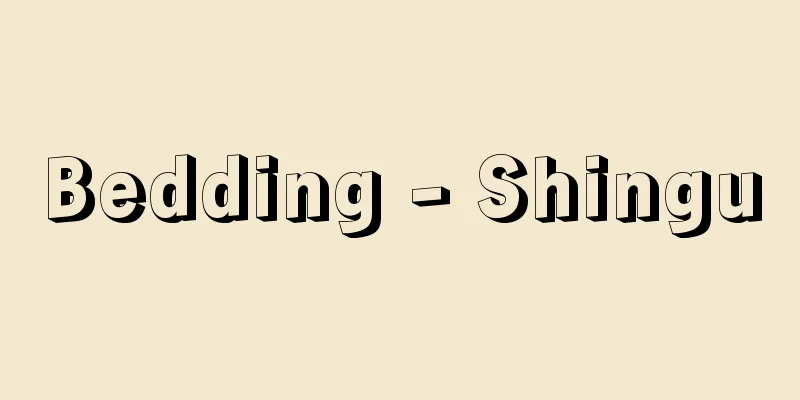Bedding - Shingu

|
A general term for the equipment used for sleeping. Bedding includes everything needed to sleep, such as futons, nightwear, sleeping covers, blankets, towels, pillows, sheets, nightwear, mosquito nets, mattresses, beds, hammocks, and Schlafsacks. It is also called bedding. [Yasu Fujimoto] kindsThe main item of bedding is the futon. Futons are divided into a mattress and a comforter, and there are different types depending on the size and the way they are made. The sizes are currently standardized by the JIS (Japanese Industrial Standards). The length of a futon is 190-210 cm for both the mattress and the comforter. The length is determined according to the height. The width of the mattress can be either mino (102 cm) or yonō (135 cm). The Kanto style is a mino futon with a turn-back finish, while the Kansai style is a yonō with a mirror finish, but recently the mino futon has been used nationwide. The width of the comforter can be one of five cloths (175 cm), one half cloths (150 cm), or one half cloths (135 cm). In the past, five cloth futons were used, but today yonō futons are more commonly used. A set of bedding can be made up of two mattresses, one nightgown, one comforter, two mattresses, two comforters, one mattress, one mattress, one mattress, one comforter, etc. Since body heat is lost more easily through the mattress than through the comforter, a thick mattress and a thin, light comforter will have a greater heat retention effect and make for a comfortable sleep. Futons must meet the following criteria to help you recover from the day's fatigue and get a good night's sleep: they must be warm, absorbent and breathable, light and soft, easy to handle and hygienic, durable and economical. As long as they meet these criteria, you are free to choose the color and design. Futon fabrics include cotton fabrics such as Oume bedding, Sarasa, and Hattan, silk fabrics, and synthetic fabrics, but cotton fabrics are the best as they absorb sweat. For summer blankets, linen and chijimi fabrics are used. The filling material used for futon mattresses is almost always cotton, which has excellent heat retention, elasticity, and moisture absorption and permeability. For comforters, in addition to cotton, feathers, silk cotton, wool cotton, and the newly developed synthetic cotton are used. Synthetic cotton has the advantage of being light and warm, but the disadvantage is that it is sensitive to heat, so when using hot water bottles or kotatsu, care must be taken not to let them come into direct contact with the futon to prevent deterioration due to heat. Mattresses come in foam rubber, made by lathering and solidifying natural rubber, and polyurethane foam, made from synthetic resin instead. Both have heat retention properties, but they have low moisture absorption and permeability, so it is best to use them under a cotton mattress. However, they have the disadvantage of being prone to aging when exposed to heat or direct sunlight. Nightgowns and kaimaki are padded bedding with a collar and sleeves that fit the body well and prevent drafts from coming in from the shoulders, making them ideal for keeping the shoulders warm, but they are becoming less commonly used. This is because there are fewer makers of them, as they require skill to make, and because simple blankets have become more widely used. Recently, modified nightgown-style blankets have been made that cover the shoulders. Nightgowns and kaimaki are still made for bridal bedding today. Blankets are made of woolen or cotton-blend yarn, and because they have long fibers, they have a high air content and are excellent at retaining heat. They need to be cared for so that the fibers do not flatten. Today, warm and light synthetic blankets are widely used. It is a good idea to cover these blankets with moisture-absorbing cotton fabric. Towel blankets are made of thick cotton or synthetic fabrics and are primarily used as summer blankets. Cotton towel blankets are used throughout the year under synthetic duvets. Pillows are of the kukurimaku type, and are made from buckwheat husks, red beans, cotton, koji, foam, etc. For summer, there are rattan and ceramic pillows, which are designed to counter the old saying that the head is cool and the feet are warm. Cotton fabrics are suitable for bed sheets. Cotton-shrunk fabrics or linen fabrics are used in the summer. Negoza mats are used on humid summer nights. For winter bed sheets, thick brushed flannel-like fabrics made from a cotton/synthetic blend are also used. Covers include futon covers, blanket covers, pillow covers, and bed covers, and some are not only hygienic but also decorative. Washable cotton fabrics such as calico, tenjiku, and broadcloth are suitable for the fabric. The dimensions of ready-made covers are made to JIS standards. Futon and blanket covers come in bag-shaped and frame-style shapes. Zippers or snaps are attached to make it easy to take futons and blankets in and out. Pillow covers come in cover-style and bag-style, and are made larger. Bed covers are a covering cloth that is draped over the bed, and are made with consideration given to the color and design of furniture, curtains, etc. from the perspective of interior decoration. There are two types of nightwear: Japanese style and Western style. Since it is worn directly against the skin, it serves as both underwear and outerwear, and it is best to wear something that can withstand washing, such as cotton fabric. There are mosquito nets for Japanese-style rooms, mosquito nets for Western-style beds, and mosquito nets for children to nap on. They are made from materials such as hemp and cotton and come in colors such as white, light blue, and green. They used to be a part of the summer scenery, but the development of sewer systems has recently almost completely eradicated the breeding of mosquitoes, and demand is decreasing. The bed is a Western-style bed platform, first used in hospitals and the military in Japan. With the advent of hotels, beds came into contact with the everyday lives of ordinary people, and are gradually being used in homes as well. In the early days, the springs were soft and tall, but ergonomic research has led to improvements in height and elasticity to suit Japanese people, and this is still the case today. There are two types of bed springs: linked type, in which independent springs are linked together, and linked type, in which springs are tied together with iron wire. Care must be taken as the metal of the springs can rust and become deformed. There are two sizes of beds: single and double, with single beds being 1 meter wide and 2 meters long, and double beds being 1.4 meters wide and 2 meters long. Semi-double beds are 1.26 meters wide and 2 meters long. [Yasu Fujimoto] historyHistorically, bedding has consisted of a bedding, a cover, and a pillow. In ancient times, due to the style of housing, many people would lie down on the wooden floor of the dirt floor, or on straw mats or mats to relax after a long day. Straw mats were generally used more often. From the images of people resting on familiar straw mats, which can be seen in various paintings, we can get a glimpse of the lives of ordinary people at that time. Some people slept on rice straw or furs. Pillows used included grass pillows, straw pillows, reed pillows, small boxwood pillows, rattan pillows, wooden pillows, stone pillows, and pillow-like pillows. It seems that straw mats were an essential item even within the Imperial Court. There were varieties such as ayamushiro, samushiro, ryubin, and inamushiro, and those involved in beating straw mats were incorporated into the Ritsuryo system. They were given the name of their place of origin, such as Izumo straw mats, Kuzuno straw mats, Suo straw mats, Wakasa straw mats, and Azuma straw mats, and were paid as tribute by commoners. Straw mats were made from mandarin orange, a member of the grass family, and other varieties included kansen straw mats, yosen straw mats, and bosakusen straw mats. Commoners slept in their underwear or naked, draping the jacket they had worn during the day over their heads. This way of sleeping continued until around the beginning of the 20th century. Tatami mats were used in the mansions of aristocrats and powerful families, and in the residences of large temples. Tatami mats were not like we know them today, but were more like straw mats or straw mats. Straw mats were often made from straw, with rush, cattail, and bamboo also used. Tatami mats were classified according to the material they were made from, such as reed tatami, leather tatami, and silk tatami. Around the 9th century, tatami mats of an appropriate width and length for people to sleep on were made. These mats were called tatami mats, and circular cushions were placed on them to sit on during the day, and used as bedding at night. Common people's homes did not have tatami mats. The pillows, sliding doors, and tatami mats among the Shosoin treasures are the oldest relics in Japan. The bed of Emperor Shomu (reigned 724-749) is the oldest bed in Japan. Ancient beds were used by people of very limited status, such as the emperor and empress. Beds have made little progress in Japan since then, but they can be seen being used by Toyotomi Hideyoshi in Osaka Castle in the 16th century. In the Heian period, aristocrats would lay two tatami mats on the floor, put up a curtain over them, and then lay a futon inside, place a pillow under it, and cover themselves with a futon to rest. A futon is equivalent to a hanging futon, and can be a hitatare futon with a collar and sleeves, an uchiki, or a tonoimono. At that time, men wore eboshi hats on their heads even when they went to sleep. This sleeping arrangement can be seen in picture scrolls such as "The Tale of Genji Illustrated Scroll" and "The Legend of Kitano Tenjin Illustrated Scroll." In the medieval picture scroll "Kasuga Gongen Reigenki," the curtains have disappeared, and the guests sleep on a mat laid on top of the tatami mats. The mats are made of twill silk or tatami mats on the front and are bordered on all four sides with brocade, and are usually filled with cotton or silk cotton. This became common during the Kamakura and Muromachi periods. In the early modern period, with the spread of cotton, nightgowns and futons evolved from hitatare futons and have continued to be used to this day. Nightgowns are worn when sleeping at night, and it was only after the Keicho and Genna eras (1596-1624) that the yukuchomono was revised and became the standard. Before that, people wore small nightgowns, which were slightly larger than the mo (skirt), and slept with a futon over them. Futon means sleeping clothes, and is something that covers the body when sleeping. Later, it was called a futon. Most are made of silk twill, 8 shaku (about 240 cm) long and 8 or 5 pieces wide, and two thick strands of crimson nerito (thread) are sewn side by side at the neck, which is what we call a pillow mark today. Kamibusuma (paper futon) is a futon made of Japanese paper, and was widely used by the general public in the past because it is light, warm, inexpensive, and durable. It was produced in Sendai, Oshu, and Abekawa, Suruga. It was highly valued for travel because it was simple and easy to carry. In the Edo period, there was a person called Tentokuji who peddled paper futons in Edo until the mid-Edo period, but later stopped doing so. [Yasu Fujimoto] "History of Bedrooms and Bedding" by Mitsuaki Ogawa (1973, Yuzankaku Publishing) [Reference items] | | | | | | | |The nobles would set up curtains to make a sleeping space, cover themselves with night-watch futons, and sleep on the tatami mats. In those days, they would even wear eboshi hats when sleeping. "Genji Monogatari Emaki" "Kashiwagi" (copy held at the National Diet Library ) Bedding from the Heian Period A tatami mat is laid on the wooden floor, a blanket is laid on top of it, and a wide-sleeved robe is used as a cover. The nun at the back is using a mosquito net. "Kasuga Gongen Miracle Record" (copy held at the National Diet Library ) Bedding from the Kamakura Period Source: Shogakukan Encyclopedia Nipponica About Encyclopedia Nipponica Information | Legend |
|
寝るのに用いる用具の総称。ふとん、夜着、かい巻、毛布、タオルケット、枕(まくら)、敷布、寝巻、蚊帳(かや)、マットレス、ベッドそして、ハンモックやシュラーフザックなど、寝るために必要なものすべてが寝具に含まれる。夜具ともいう。 [藤本やす] 種類寝具の中心になっているものは、ふとんである。ふとんには敷きぶとん、掛けぶとんの別があり、大きさ、仕立て方による種類がある。大きさは現在JIS(ジス)規格により統一されている。ふとんの長さは、敷きぶとん、掛けぶとんともに190~210センチメートル。身長にあわせて丈を定める。敷きぶとんの幅は三布(みの)(102センチメートル)と四布(よの)(135センチメートル)とがある。関東式は三布ふとん引返し仕立て、関西式は四布ふとん鏡仕立てであるが、最近は全国的に三布引返し仕立てを用いている。掛けぶとんの幅は五布(いつの)(175センチメートル)、四布半(150センチメートル)、四布(135センチメートル)の種類がある。以前は五布ふとんが用いられたが、今日では四布半のふとんが多く用いられている。 夜具一組は敷きぶとん2枚・夜着1枚・掛けぶとん1枚、敷きぶとん2枚・掛けぶとん2枚、敷きぶとん1枚・マットレス1枚・掛けぶとん1枚など各種の組合せをする。体熱は掛けぶとんより敷きぶとんから失われやすいから、敷きぶとんを厚くし、掛けぶとんは薄く軽くすると、保温効果が大きく、寝心地がよい。 ふとんは、1日の疲れをいやし、十分な睡眠がとれるよう、次のような条件を備えていなければならない。保温性があること、吸湿・透湿性があること、軽くて柔らかいこと、取扱いが容易で衛生的であること、耐久性があり経済的であることなどである。これらの条件を備えたうえで、自由に色彩やデザインに配慮する。ふとん地は青梅(おうめ)夜具地、更紗(さらさ)、八端(はったん)など綿織物、絹織物、ほかに化合繊の織物があるが、汗を吸い取る綿織物がもっともよい。夏掛け用には麻、縮(ちぢみ)を用いる。 ふとんの詰め物(充填(じゅうてん)材)は、敷きぶとんには保温性、弾力性に富み、吸湿・透湿性に優れている木綿綿(もめんわた)がもっぱら用いられる。掛けぶとんには木綿綿のほかに羽毛、絹綿、羊毛綿、また新しく開発された合成綿が用いられている。合成綿は、軽くて暖かい長所をもっているが、熱に弱い欠点があり、湯たんぽ、こたつなどを使用するときは、直接ふとんに触れないように注意し、熱による変質を防ぐ必要がある。 マットレスには、天然ゴムを泡立てて固めたフォームラバーや、これにかわって合成樹脂でつくられたポリウレタンフォームなどがある。いずれも保温性はあるが、吸湿・透湿性が少ないので、木綿綿の敷きぶとんの下に併用するほうがよい。なお熱や直射日光に当てると老化しやすい欠点がある。 夜着、かい巻は、衿(えり)、袖(そで)のついた夜具用の綿入れで、体になじみ、肩からのすきま風を防ぐので肩の保温に適しているが、一般に使用されなくなってきている。これは、製作に技術を要するために製作者が少なくなっていることと、簡便な毛布の利用が多くなったためである。最近、毛布で肩を覆う夜着風に手を加えたものもできている。婚礼用の組み夜具には、現在も夜着またはかい巻がつくられている。 毛布は紡毛糸や綿混紡糸を用いたもので、毛足があるため、含気量が多く保温性に富む。毛足を寝かせないように手入れをする必要がある。今日では暖かく軽い合繊の毛布が多く用いられるようになった。これには吸湿性のある綿織物でカバーをするとよい。 タオルケットは綿、化繊など厚手のタオル地でつくられ、おもに夏掛け用として用いる。綿のタオルケットは、化合繊の掛けぶとんの下に四季を通して用いられる。 枕は括枕(くくりまくら)系のものが用いられ、中にはそば殻、小豆(あずき)、綿(わた)、パンヤ、フォームなどが用いられる。夏用に籐(とう)製、陶製などがあり、古くからいわれている頭寒足熱に対応するくふうがなされている。 敷布には綿織物が適当である。夏季用に綿縮(めんちぢみ)や麻織物が用いられる。夏の蒸し暑い夜には寝茣蓙(ねござ)が用いられる。冬の敷布としては、綿・化繊混紡の厚手の織物を起毛したフラノ風のものも用いられている。 カバーには、ふとんカバー、毛布カバー、枕カバー、ベッドカバーなどがあり、衛生面ばかりでなく、装飾を兼ねたものもある。布地はキャラコ、天竺(てんじく)、ブロードなど、洗濯に耐える綿織物が適当である。既製品のカバーの寸法はJIS規格にあわせてつくられている。ふとん・毛布カバーの形状は、袋状のものと額縁式のものとがある。ふとん、毛布などの出し入れに便利なように、ファスナーまたはスナップをつける。枕のカバーは覆い式と袋式とがあり、大きめにつくる。ベッドカバーは、ベッドに掛ける覆い布をいい、室内装飾の面からも家具やカーテンなどとの配色、デザインなどを考えてつくる。 寝巻には、和服形と洋服形とがある。直接肌につけるから、肌着と上着を兼ね備えたもので、洗濯にじょうぶなものがよく、綿織物が適当である。 蚊帳には、和室の座敷用蚊帳、洋式ベッド用蚊帳、子供の昼寝用の幌(ほろ)蚊帳がある。材料は麻、綿などが用いられ、色は白、浅葱(あさぎ)、緑などで、夏の風物の一つであったが、最近下水道の発達によってカの発生がほとんどなくなり、需要が減少している。 ベッドは西洋式寝台で、日本では最初に病院や軍隊で使用された。ホテルの出現により一般の人々の生活と接触するようになり、家庭にも徐々に用いられるようになってきている。初期はスプリングが軟らかく高さも高かったが、人間工学的研究により高さと弾性とが日本人向きに改良されて、今日に至っている。ベッドのスプリングは、独立したばねを連繋(れんけい)した連繋式と、ばねを鉄線で結んだ連結式とがある。ばねの金属がさびたり変形することがあるので注意を要する。ベッドの大きさには、シングルとダブルの2種があり、シングルは幅1メートル、長さ2メートル、ダブルは幅1.4メートル、長さ2メートルである。セミダブルは幅1.26メートル、長さ2メートル。 [藤本やす] 歴史寝具は歴史上から、敷く物、掛ける物、枕とからなっている。古代においては住居形式から、多くの人は土間の板敷きの上にごろ寝をしたり、菰(薦)(こも)や筵(蓆)(むしろ)を敷いてその上に横になり、1日の疲れをいやしていたようである。一般には筵のほうが多く用いられていた。各種の絵画にみられる使い慣れた筵を敷き、また上にかけて手枕をして休んでいる姿から、当時の庶民の生活の一端をうかがうことができる。なかには稲藁(いねわら)を敷いたり、毛皮を敷いたりして横になっている者もいた。枕は草枕、薦(こも)枕、菅(すが)枕、柘(しゃ)の小枕、籐枕、木枕、石枕など、また括枕のようなものなどが用いられた。 宮中でも、筵(蓆)はなくてはならないものであったようである。綾蓆(あやむしろ)、狭(さ)蓆、竜鬢(りゅうびん)蓆、稲(いな)蓆などがあり、律令(りつりょう)制のなかに筵打ちに携わる者が編入されている。出雲筵(いずもむしろ)、葛野(くずの)筵、周防(すおう)筵、若狭(わかさ)筵、東(あずま)筵など、産地名をつけて庶民より貢納されていた。薦(こも)はイネ科のマコモでつくられ、ほかに菅薦(かんせん)、葉薦(ようせん)、茅簀薦(ぼうさくせん)などがあった。 庶民は下着のままか、裸のままで寝て、上には昼間着ていた上着をかけていた。この就寝の方法は20世紀の初めごろまで行われていた。貴族、豪族の屋敷や大寺院の住居には畳が用いられていた。畳は今日いうようなものではなく、薦や筵のようなものであった。筵の材料は藁が多く、藺(い)、蒲(がま)、竹などが用いられた。畳は菅畳(すがだたみ)、皮畳、絹畳など、材料による区分がなされた。9世紀ごろ、人が寝るのに適当な幅や長さのものがこしらえられた。これが畳といわれる敷物で、昼はその上に円座を敷いて座し、夜は寝具に用いられていた。庶民の家には畳はなかった。 正倉院宝物のなかにある枕、衾(ふすま)、畳はわが国最古の遺品である。また聖武(しょうむ)天皇(在位724~749)の御床は、わが国における最古の寝台である。古代の寝台は天皇、皇后などきわめて限定された身分の人たちに用いられた。日本では寝台はその後ほとんど発展しなかったが、16世紀、豊臣(とよとみ)秀吉が大坂城内で用いているのをみることができる。 平安時代の貴族は、床の上に畳二つを並べてその上に御帳(みちょう)を立てて寝所をつくり、内部に茵(褥)(しとね)を敷き、枕をあてがい、衾をかけて休んだ。衾は掛けぶとんに相当し、衿や袖のついた直垂衾(ひたたれぶすま)、袿(うちき)、宿直物(とのいもの)などを用いている。当時男子は、寝るときも頭に烏帽子(えぼし)をつけていた。この就寝のようすは、『源氏物語絵巻』『北野天神縁起絵巻』などの絵巻物にみることができる。 中世の絵巻『春日権現霊験記(かすがごんげんれいげんき)』には御帳の姿は消えており、主人たちは畳の上に上筵を敷いて寝ている。上筵は綾絹(あやぎぬ)とか畳表を面(おもて)にして、四方を錦(にしき)で縁どりをしたもので、なかには主として綿(わた)、絹綿を入れたものが用いられた。これが一般化して用いられるようになったのは、鎌倉時代から室町時代である。 近世において木綿綿の普及により、直垂衾から発展した夜着とふとんが用いられるようになって、今日に至っている。 夜着は夜寝るときに着るもので、宿直物が改められ、これをもっぱら用いるようになったのは慶長(けいちょう)・元和(げんな)(1596~1624)以後である。これ以前は小寝衣といって裳(も)の衣服より少し大きいものを着て、その上に衾をかぶって寝ていた。衾は臥裳(ふすも)の意で、寝るとき身を覆うものである。のちにはふとんといわれているものである。多くは絹綾などでつくり、長さ8尺(約240センチメートル)、広さ八布あるいは五布で、首のほうには紅(くれない)の練糸(ねりいと)を太く撚(よ)って二筋並べ横に縫い、今日いう枕上の印とした。紙衾(かみぶすま)は和紙でこしらえた衾で、軽く、暖かく、安価で、じょうぶであることなどから、古く民間で多く用いられた。産地は奥州仙台、駿河(するが)安倍川(あべかわ)であった。旅などには、簡単で持ち歩きに便利なため重宝された。江戸時代、江戸では紙衾を天徳寺(てんとくじ)といって、江戸中期ごろまで行商していた者があったが、のちにはとだえた。 [藤本やす] 『小川光暘著『寝所と寝具の歴史』(1973・雄山閣出版)』 [参照項目] | | | | | | | |御帳を立てて寝所をつくり、宿直物の衾をかけ、畳の上に寝る貴族。当時は寝るときも烏帽子をつけていた。『源氏物語絵巻』 「柏木」 写国立国会図書館所蔵"> 平安時代の寝具 板床に畳を敷き、その上に茵をのべ、広袖の衣服を上掛けにした寝具。奥側の尼は蚊帳を使っている。『春日権現霊験記』 写国立国会図書館所蔵"> 鎌倉時代の寝具 出典 小学館 日本大百科全書(ニッポニカ)日本大百科全書(ニッポニカ)について 情報 | 凡例 |
Recommend
Ultimate Particle - Ultimate Particle
… [Chemical elements and simple substances] An el...
Matamata - Again (English spelling) matamata
This turtle belongs to the order Testudins, famil...
War correspondent - jugunkisha
A journalist is a person who is sent to the battl...
Sastre, A. (English spelling) SastreA
...However, these were only sporadic examples and...
Archer - Yunde
Another name for the left hand. It is a phonetic ...
Knights of Alcantara - Knights of Alcantara
…In the Christian world, it refers to an organiza...
Tentenshu - Amanotamusake
...It is believed that the Sumerians were already...
New York Financial Market
The world's largest international financial ma...
Czepko, D.von (English spelling) CzepkoDvon
…He studied medicine in various places and became...
Yavamadhya
…(2) Measures based on the size of natural object...
Tubular gland - Kanjosen
...Glands are divided into several types accordin...
Haplocarida
...A general term for arthropods belonging to the...
Chika Island - Chika Island
The ancient name of the Goto Islands in Nagasaki ...
Chrysanthemum carinatum (English spelling) Chrysanthemumcarinatum
…[Munemitsu Yanagi] [Mitsuru Hotta]. … *Some of t...
al-Istakhrī (English spelling)
A Muslim geographer of the 10th century. Author of...



![Mitsugi [town] - Mitsugi](/upload/images/67ccf268631d0.webp)
![Otobe [town] - Otobe](/upload/images/67cb1febdf2bc.webp)




